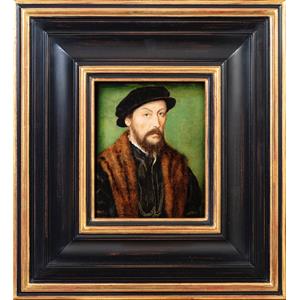IMAGE DETAILS

Franck Anelli Fine Art
Claude Corneille de Lyon (The Netherlands, The Hague 1500-1575 Lyon, France)
Portrait of a wealthy merchant wearing a fur-lined coat and gold chain, circa 1560
Oil on panel
15 x 18 cm
Certificate from Dr. Alexandra Zvereva
This painting will be included in the supplement to the artist's forthcoming Catalogue Raisonné
This unpublished small portrait fits naturally into the later works of one of the most illustrious portraitists of the French Renaissance. Referred to in contemporary documents by the name of his hometown, La Haye, he later became known simply as 'Corneille' until André Félibien, who believed him to be from the banks of the Rhône, added the name 'Lyon' in the index of his Entretiens. Born and trained in the Netherlands, probably in Flanders, the artist settled in Lyon as early as 1533. There, he succeeded Jean Perréal, the portraitist of Charles VIII and Louis XII, renowned for his intimate portraits with coloured backgrounds. By the mid-1530s, Corneille had gained such fame that he found himself painting the courtiers accompanying the king to Lyon, as well as the Sons and Daughters of France. However, unlike Perréal, his career was not that of a royal artist following the court. He never left Lyon, and his titles of "painter to the Dauphin" and later "painter and ordinary valet to the king" were purely honorary, primarily granting him the privileges of royal officers. The prominent citizens of Lyon, wealthy French and foreign merchants, high-ranking royal officers, well-to-do bourgeois, and magistrates made up the bulk of his clientele. Corneille created small-scale portraits for them, painted in just a few sitting sessions directly onto panels. Intended for family and close associates, these works had no official circulation and existed in only one unique copy, unlike portraits of the nobility, of which Corneille often made replicas that were widely circulated.
The subject of this portrait is not a nobleman, despite his evident wealth. His attire is simple, a dark brown-black without any ornamentation, slashing, or jewels. The white ruff of his shirt is not starched. His high cap, fashionable in the 1550s-1560s, lacks a plume, a privilege reserved for the nobility, as it was associated with the feathers adorning knights' helmets. However, the man does possess a certain fortune, as evidenced by his fur-lined cloak of marten with wide lapels and a large gold chain with three rows of links, favoured by the Flemish. The medallion on the chain is cropped by the frame. This is almost certainly a prosperous merchant, eager to demonstrate his success and preserve the memory of his features for his family. The absence of any inscription on the reverse, giving the name of the subject, makes identification impossible, since no replica or engraving exists.
Despite previous restorations, particularly to the face and background, the distinctive characteristics of Corneille’s art are clearly visible here, such as the rough sketching of the ear, the sloping shoulders that make the head appear slightly disproportionate to the torso, the treatment of the hair with individual strands, the brilliant irises crossed by an oblique ray of light, and the broader brushstrokes in the clothing.



 download image
download image